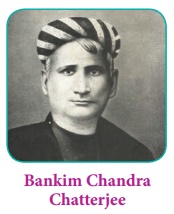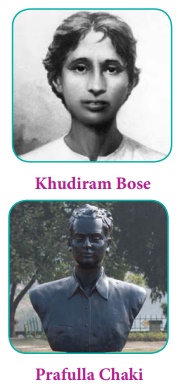Rise of Extremism and Swadeshi Movement | History - Revolutionary Extremism | 12th History : Chapter 2 : Rise of Extremism and Swadeshi Movement
Chapter: 12th History : Chapter 2 : Rise of Extremism and Swadeshi Movement
Revolutionary Extremism
Revolutionary Extremism
Around 1908, the decline of the militant
nationalists and the rise of revolutionary activities marked an important shift
from non-violent methods to violent action. It also meant a shift from mass-based
action to elite response to the British rule. In Bengal, revolutionary
terrorism had developed even earlier; around the 1870s, when the akharas or
gymnasiums were setup in various places to develop what Swami Vivekananda had
described as strong muscles and nerves of steel. Bankim Chandra Chatterjee’s
novel, Anandmath also had a
significant impact. Anandmath was
widely read by the revolutionaries in Bengal. The Bande Mataram song, which is
part of the novel, became the anthem of the swadeshi movement.

During the Swadeshi movement three factors
contributed to the upsurge in the individual acts of violence:
·
The apolitical constructive programmes had little
acceptance among the youth who was growing impatient under the repressive
foreign rule.
·
The failure of the militant nationalists to lead
the young people into a long-term mass movement also contributed to the growth
of individual action.
·
The revolutionary action was part of an effort
towards the symbolic recovery of Indian manhood, which the revolutionaries
believed was often challenged and looked down upon by the British.
Such actions, however, did not lead to any
organised revolutionary movement as was the case in Russia. The revolutionary
actions were mostly attempts to assassinate specific oppressive British
officers.
(a) Alipore Bomb Case
In Bengal, the story of revolutionary terrorism
begins in 1902 with the formation of many secret societies. Most notable among
them all was the Anushilan Samity of Calcutta, founded by Jatindernath Banerjee
and Barindarkumar Ghose, brother of Aurobindo Ghose. Similarly, the Dhaka
Anushilan Samity was born in 1906 through the initiative of Pulin Behari Das.
This was followed by the launch of the revolutionary weekly Yugantar. The Calcutta Anushilan Samity
soon started its activities and the first swadeshi dacoity, to raise funds, was
organised in Rangpur in August 1906.
In the same year, Hemchandra Kanungo went abroad to
get military training in Paris. After his return to India in 1908, he
established a bomb factory along with a religious school at a garden house in
Maniktala. In the same garden house, young inmates underwent various forms of
physical training, reading classic Hindu text, and reading literature on
revolutionary movement across the world.

A conspiracy was hatched there to kill Douglas
Kingsford, notorious for his cruel ways of dealing with the swadeshi agitators.
Two young revolutionaries - 18-year-old Khudiram Bose and 19-year-old Prafulla
Chaki – were entrusted with the task of carrying out the killing. On 30 April
1908, they mistakenly threw a bomb on a carriage, that, instead of killing
Kingsford, killed two English women. Prafulla Chaki committed suicide and
Khudiram Bose was arrested and hanged for the murder.
Aurobindo Ghose, along with his brother Barinder
Kumar Ghose and thirty-five other comrades, were arrested. Chittaranjan Das
took up the case. It came to be known as the Alipore Bomb case.
The judgement observed that there was no evidence
to show that Aurobindo Ghose was involved in any conspiracy against the British
rule. Ghose was acquitted of all the charges. Barindra Ghose and Ullaskar Dutt
were given the death penalty (later commuted to the transportation of life),
with the rest being condemned to transportation for life. The year-long hearing
of Alipore Bomb case made a great impact and portrayed the nationalist
revolutionaries as heroes to the general public.
Trial and the Aftermath
After his acquittal, Aurobindo Ghose took to a
spiritual path and shifted his base to Pondicherry, where he stayed until his
death in 1950. The idea of bringing an armed revolution, envisaged by Aurobindo
Ghose, never materialized. The reason for the gradual decline in the
revolutionary activities in Bengal was a combination of government repression
and alienation from the people. Beside this, revolutionary terrorism suffered
from certain social limitations too as most of the revolutionaries were drawn
from the three upper castes – Brahmin, Kayastha, and Vaishya.
(b) British Repression
In December 1908 the Morley-Minto constitutional
reforms were announced. The moderates welcomed the reforms. However, they soon
realised that there was hardly any shift of power. In fact, measures taken by
Minto were highly divisive as it institutionalised communal electorates
creating Hindu-Muslim divide. Beside this, the colonial government also
introduced certain repressive laws such as:
·
The Newspapers (Incitement to Offence) Act, 1908.
This act empowered the magistrate to confiscate press property which published
objectionable material making it difficult to publish anything critical of
British rule.
·
Indian Press Act 1910 made it mandatory for
publishers and the printers to deposit a security that could be seized in case
they printed ‘obnoxious material’.
·
The Indian Criminal Law Amendment Act allowed
summary trails and also imposed the prohibition of ‘association dangerous to
the public peace’.
Even with the widespread repression, the charm of
revolutionary action never disappeared from the Indian national movement. The
centre of activities moved from Bengal to Uttar Pradesh and Punjab.
Related Topics